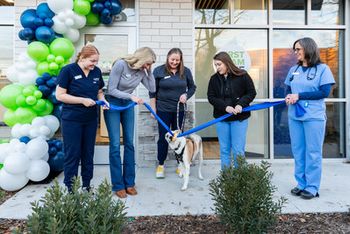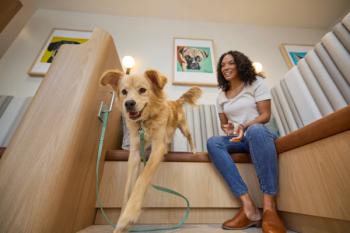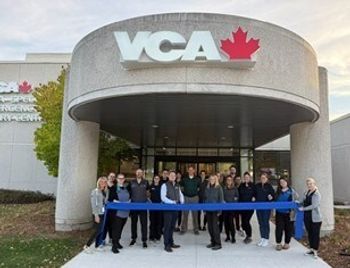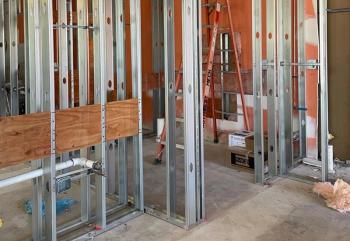
Enjoying perfect timing
Good luck and support from her family made all the difference when Dr. Sue A. Stiff was building a new facility for Kiln Creek Animal Care in Newport News, Va. Most business owners in this seaside locale can't afford land. But fortune smiled when Dr. Stiff secured a 2.7-acre site in an exclusive golf community--for half its value. In addition, her husband, a local emergency veterinarian, kept an eye on the practice while she devoted her time to the building project.
By Carolyn Chapman, special assignments editor
Good luck and support from her family made all the difference when Dr. Sue A. Stiff was building a new facility for Kiln Creek Animal Care in Newport News, Va. Most business owners in this seaside locale can't afford land. But fortune smiled when Dr. Stiff secured a 2.7-acre site in an exclusive golf community--for half its value. In addition, her husband, a local emergency veterinarian, kept an eye on the practice while she devoted her time to the building project.
Dr. Stiff's eye-catching 6,180-square-foot cedar-shingled building captured praise from the judges of Veterinary Economics' 2000 Hospital Design Competition. They lauded the facility's charming exterior, interesting treatment island, and attractive reception area. "It's hard to find fault with this hospital," one judge said.
Nestled among trees
Dr. Stiff opened Kiln Creek Animal Care in a golf community in 1992, five years after graduating from Virginia Tech. A year later, she expanded the 2,000-square-foot strip-mall leasehold into an adjacent bay and added an associate, but she dreamed of owning a freestanding facility. "The leasehold had a great floor plan, but we were quickly outgrowing the space," Dr. Stiff says.
When the golf community developer went bankrupt, a new developer took over and planned to build condominiums on a plum site in front of the country club. Neighbors balked, saying the plan would destroy too many trees. So Dr. Stiff bid on the land, and clients who were members of the homeowner's association backed her. "It couldn't have worked out better," she says. With the low land price, she bought more than she needed and subdivided the land into lots of 1.7 and 1 acres for future expansion.
A 10-year history in the area and an organized business plan helped Dr. Stiff secure financing. Financial paperwork, an artist's rendering, and support from area homeowners swayed the zoning board to designate the property commercial. And when the city manager learned Dr. Stiff planned a green roof on the cedar building, he approved immediately. "He really likes green roofs," she says, laughing.
To design the project, Dr. Stiff interviewed two veterinary architects but eventually hired local designer Greg Battaglia, who's married to her associate, Dr. Louise Battaglia. "Designing his wife's workspace gave him a vested interest in the project," Dr. Stiff says. And Battaglia went the extra mile to make his first veterinary project a great one. "He interviewed every staff member to learn how the design could make their jobs easier," Dr. Stiff says.
Battaglia and Dr. Stiff visited area veterinary clinics to study traffic flow and toured industrial facilities to examine materials. To help team members visualize the new hospital, Dr. Stiff drew a full-scale plan in chalk in a large cul-de-sac. "Walking from room to room gave us a true sense of the size and flow," she says.
Construction proceeds well
Dr. Stiff worked full time during construction, and her husband filled in as needed so she could still visit the construction site every day. She says a successful project requires such support. "Building projects are never fun, but supportive co-workers and family make the process easier," Dr. Stiff says.
Working with an experienced builder who knew his subcontractors expedited the project as well, she says. Dr. Stiff chose a residential builder to transform the architect's detailed plans into reality. "The home builder had worked with cedar shake before, which we considered an advantage," Dr. Stiff says. She also hired a contractor from New Jersey to install the in-line oxygen system with quick-release ports.
Only one disaster struck during the building phase. The shingle framer missed the reference lines at the back for air-conditioning refrigerant lines. When nailing the shingles, he pierced all five lines repeatedly. "We didn't catch the problem until we tried using the air conditioning with no results. We had to remove the shingles and replace the piping," Dr. Stiff says.
Rectangles are boring
Thanks to the building's unique angles, Dr. Stiff preserved many trees--she only had 13 cut down--and kept the kennels away from nearby homes. A flexible core structure offers room to expand the treatment area, surgery suite, or kennels.
Cedar shake shingles and the green shingled roof give the hospital a farmhouse feel. Dr. Stiff realizes the shingles require more maintenance than other materials but likes how the building blends with the trees. "Our hospital doesn't look like anything else around here," she says. "We're surrounded by brick and siding structures, and we look like we stepped out of Cape Cod." An arbor with white pillars and vines adds to the appeal.
Clients entering the hospital enjoy a mural depicting Brandy, a canine patient who is now deceased, and the artist's cats. The mural proved so popular, Dr. Stiff plans to place a similar piece near the exit.
Dramatic ceiling beams in the reception area came from a local peanut barn and date to the late 1800s. "The architect wanted a vaulted ceiling but needed something to break up the space and buffer noise," Dr. Stiff explains.
Sliding glass doors in the reception area let clients observe grooming and see the cat condos and cat adoption area. And Dutch doors in the four exam rooms keep clients and pets from feeling penned in.
To maintain efficiency in the working areas, Dr. Stiff included a lazy Susan in the treatment area where it's in easy reach of the three workstations. She also placed a doctors' station between the pharmacy and the treatment area.
Dr. Stiff chose to keep the boarding area small. "We want to focus more on medicine," she says. However, as more clients request doggie daycare, she's considering a separate on-site boarding kennel. To give boarded pets a place to stretch their legs, the hospital features a large back yard with a privacy fence.
Now that the project is complete, Dr. Stiff admits she should have paid more attention to materials. She's investigating sound baffles in the reception area, and she recently replaced the kennel ceiling with dropped acoustical tile. To prevent water from collecting on the windows in winter, Dr. Stiff installed an energy recovery system. She also plans to replace the kennel floor with poured epoxy polymer. "We probably tried to cut corners where we shouldn't have, but we can afford to upgrade now," she says.
Filling the new space hasn't been difficult. The practice has grown quickly, prompting Dr. Stiff to hire two new associates. Was the journey worth it? "Absolutely," she says. "We feel pretty spoiled."
Carolyn Chapman, a former Veterinary Economics associate editor, is a freelance writer in Liberty, Mo.
August 2000 Veterinary Economics
Newsletter
From exam room tips to practice management insights, get trusted veterinary news delivered straight to your inbox—subscribe to dvm360.




